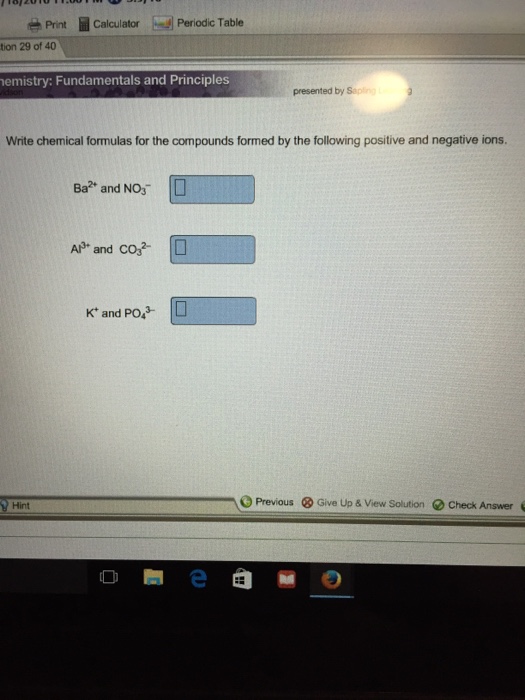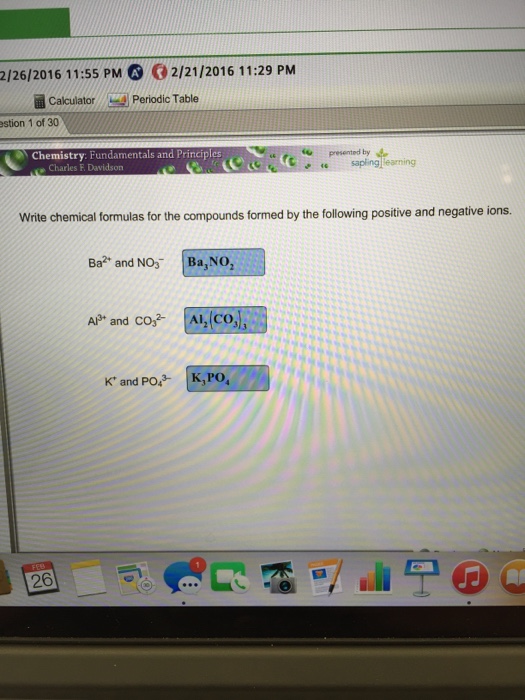Chemical Formula Writing. The procedure that can be followed when confronted with the name of a compound and you wish to write its formula is as You ask yourself do the total positive charge and total negative charge add up to zero. If the answer is no then we ask how many of each ion must we...You must provide the number of each ion that will make the overall ionic compound neutral (0 charge). So look at the charges for Ba2+ and NO3 So the formula would be Ba(NO3)2. In the formula, the Ba has a subscript of 1 (not shown; if no subscript it is assumed to be "1"), and the...Chapter 9 Chemical Names and Formulas. 4. Write formulas for the following ionic compounds. Complete this table by writing correct formulas for the compounds formed by combining positive and negative ions. Al(all). Name.Hence, the ionic compound potassium chloride with the formula KCl is formed. A positive ion, Ca2+ is formed. The two electrons lost by the calcium atom are transferred to the sulphur atom. A negative ion, F- is formed. During bond formation: One magnesium atom combines with two fluorine...An ionic compound is a substance composed of oppositely charged ions held together by the attractive forces between opposite For an electrically neutral ionic compound, the sum of the positive charges. 4. For the following compounds, write all ions needed to form the compound.
Write the chemical formula for the compound formed by each pair...
Brainly User Brainly User. Hey Friend, The cations are Ca ++ , Fe +++ , K + The anions are Cl - , SO2 -- , SO4 --. So, following compounds can be made from the given cations and anions, CaSO4 (calcium sulphate).Ionic compounds are composed of charged ions that are held together by electrostatic forces. A typical type of ionic compound, called a binary 1.1.1 Write the symbols for the elements in the compound. Note that the ending "ide" is used for fluoride to show that it is a negative ion of fluorine.Binary ionic compounds are named by writing the name of the cation, followed by the name of A prose is the ordinary form of written language and ordinary writing a distinguished from verse. Rules of writing formulas: * · positive ion is written first … this is usually a metal...Which of the following is true about the composition of ionic compounds? a. They are CHAPTER 9 Chemical Names and Formulas 9.1 Naming Ions Monatomic Ions: a single atom with a positive or WRITING CHEMICAL FORMULA For ionic compounds, the chemical formula must be worked out.

PDF Name Class CHEMICAL NAMES AND FORMULAS Practice Proble
To determine common ionic compounds formed by elements, keep the following in mind When you write the formula for an ionic compound, remember that the positive ion is always listed first. Write down the information you have for the usual charges of the atoms and balance them to answer...Detailed revision notes on the topic Formulae for Ionic Compounds. Written by teachers for the Edexcel IGCSE Chemistry course. Write Formulae for Compounds Formed Between the Ions Listed Above. Metals: They will lose electrons to another atom and become positively charged ions.Write formulas for the binary ionic compounds formed between the following elements: a. Sodium and Iodine b. Calcium and sulfur c. Zinc and Table sugar has the chemical formula C12H22O11. Which of the following is true? (1 point) Both compounds are held together by chemical bonds.Writing the electron configuration of an atom allows you to work out the electron configuration of 1:31 understand how the formulae of simple compounds can be obtained experimentally 1:57 (Triple only) know that anion and cation are terms used to refer to negative and positive ions respectively.How to Name and Write Forumlas for Chemical Compounds. Find and write the element symbol using the Periodic Table. Determine the ionic charge for the element. Most often polyatomic ions will have a negative charge but there a few with positive charges.
You should supply the number of each ion that can make the general ionic compound impartial (0 fee). So take a look at the fees for Ba2+ and NO3-. Ba has a +2 rate, so how many –1 fees will give you a sum of 0? A +2 rate calls for two –1 charges (two NO3–). So the system would be Ba(NO3)2. In the system, the Ba has a subscript of one (now not shown; if no subscript it is assumed to be "1"), and the (NO3) has a subscript of 2.
Al3+ and CO32- have a +3 charge and a –2 fee, respectively. You cannot multiply the smaller, –2, by a whole number to equal 3. So now you need to take into consideration what the smallest whole number is that they each go into lightly. Both 3 and 2 cross into 6 evenly; so you need two +Three charges (giving +6) to stability three –2 charges (giving –6). So the subscript for Al might be 2, and the subscript for (CO3) will likely be 3.
K+ and PO43- have a +1 rate and a –Three charge, respectively. How many +1 charges with one –Three charge do you want to equivalent zero? Another way to say it: Can you multiply the smaller magnitude quantity, 1, by an entire quantity to equivalent the greater magnitude quantity, 3? Yes, you could possibly multiply 1 by Three to equal 3, therefore, you need 3 K+1 for one PO4–3. The subscript for K shall be 3 for the one PO4–3.
K3PO4.
Des Composés 2
Ionic Compounds And Metals - PDF Free Download

Chemical Nomenclature
Solved: Part E: Writing Formulas Of Ionic Compounds Formed... | Chegg.com

Compounds: Formula And Naming Flashcards | Quizlet

Untitled
Write The Chemical Formula For The Compound Formed By Each Pair Of Positive And Negative Ions. Ba2+ - Brainly.com

Untitled
Snc 2Di Naming Compounds - Docest

Writing Formulas Criss Cross Method Worksheet Answers - Promotiontablecovers

Activity 1 - Naming Chemical Compounds

Solved: Write The Empirical Formula For At Least Four Ioni... | Chegg.com

CH 5 The Big One Flashcards | Quizlet

ELE CTf.2QN A-FFII\l \T'I
ELE CTf.2QN A-FFII\l \T'I
13.2 Naming Compounds - CPO Science

Ionic Compound ( Read ) | Chemistry | CK-12 Foundation

Solved: Chemistry: Fundamentals And Principles Write Chemi... | Chegg.com
Solved: Write Chemical Formulas For The Compounds Formed B... | Chegg.com

Naming Ionic Compounds Worksheet | Easy Hard Science

Solved: Estion 1 Of Calculator PM Periodic Table 11:29 PM | Chegg.com

0 comments:
Post a Comment